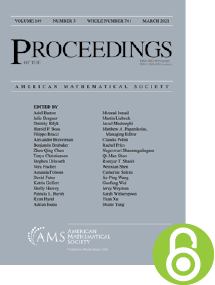A short proof of Bernoulli disjointness via the local lemma
HTML articles powered by AMS MathViewer
- by Anton Bernshteyn PDF
- Proc. Amer. Math. Soc. 148 (2020), 5235-5240
Abstract:
Recently, Glasner, Tsankov, Weiss, and Zucker showed that if $\Gamma$ is an infinite discrete group, then every minimal $\Gamma$-flow is disjoint from the Bernoulli shift $2^\Gamma$. Their proof is somewhat involved; in particular, it invokes separate arguments for different classes of groups. In this note, we give a short and self-contained proof of their result using purely combinatorial methods applicable to all groups at once. Our proof relies on the Lovász Local Lemma, an important tool in probabilistic combinatorics that has recently found several applications in the study of dynamical systems.References
- Noga Alon and Joel H. Spencer, The probabilistic method, 2nd ed., Wiley-Interscience Series in Discrete Mathematics and Optimization, Wiley-Interscience [John Wiley & Sons], New York, 2000. With an appendix on the life and work of Paul Erdős. MR 1885388, DOI 10.1002/0471722154
- Nathalie Aubrun, Sebastián Barbieri, and Stéphan Thomassé, Realization of aperiodic subshifts and uniform densities in groups, Groups Geom. Dyn. 13 (2019), no. 1, 107–129. MR 3900766, DOI 10.4171/GGD/487
- Anton Bernshteyn, Building large free subshifts using the local lemma, Groups Geom. Dyn. 13 (2019), no. 4, 1417–1436. MR 4033510, DOI 10.4171/ggd/528
- Anton Bernshteyn, Measurable versions of the Lovász local lemma and measurable graph colorings, Adv. Math. 353 (2019), 153–223. MR 3979016, DOI 10.1016/j.aim.2019.06.031
- Anton Bernshteyn, Ergodic theorems for the shift action and pointwise versions of the Abért-Weiss theorem, Israel J. Math. 235 (2020), no. 1, 255–293. MR 4068785, DOI 10.1007/s11856-019-1957-4
- P. Erdős and L. Lovász, Problems and results on $3$-chromatic hypergraphs and some related questions, Infinite and finite sets (Colloq., Keszthely, 1973; dedicated to P. Erdős on his 60th birthday), Vol. II, Colloq. Math. Soc. János Bolyai, Vol. 10, North-Holland, Amsterdam, 1975, pp. 609–627. MR 0382050
- Joshua Frisch, Omer Tamuz, and Pooya Vahidi Ferdowsi, Strong amenability and the infinite conjugacy class property, Invent. Math. 218 (2019), no. 3, 833–851. MR 4022081, DOI 10.1007/s00222-019-00896-z
- Harry Furstenberg, Disjointness in ergodic theory, minimal sets, and a problem in Diophantine approximation, Math. Systems Theory 1 (1967), 1–49. MR 213508, DOI 10.1007/BF01692494
- E. Glasner, T. Tsankov, B. Weiss, and A. Zucker, Bernoulli disjointness, arXiv:1901.03406 (preprint), 2019.
- Kashyap Kolipaka and Mario Szegedy, Moser and Tardos meet Lovász, STOC’11—Proceedings of the 43rd ACM Symposium on Theory of Computing, ACM, New York, 2011, pp. 235–243. MR 2931973, DOI 10.1145/1993636.1993669
- Michael Molloy and Bruce Reed, Graph colouring and the probabilistic method, Algorithms and Combinatorics, vol. 23, Springer-Verlag, Berlin, 2002. MR 1869439, DOI 10.1007/978-3-642-04016-0
- Joel Spencer, Asymptotic lower bounds for Ramsey functions, Discrete Math. 20 (1977/78), no. 1, 69–76. MR 491337, DOI 10.1016/0012-365X(77)90044-9
Additional Information
- Anton Bernshteyn
- Affiliation: Department of Mathematical Sciences, Carnegie Mellon University, Pittsburgh, Pennsylvania 15213
- MR Author ID: 1104079
- Email: abernsht@math.cmu.edu
- Received by editor(s): July 22, 2019
- Received by editor(s) in revised form: April 27, 2020
- Published electronically: August 5, 2020
- Additional Notes: This research was partially supported by the NSF grant DMS-1954014.
- Communicated by: Nimish Shah
- © Copyright 2020 Copyright is retained by the author.
- Journal: Proc. Amer. Math. Soc. 148 (2020), 5235-5240
- MSC (2010): Primary 37B05, 37B10; Secondary 05D40
- DOI: https://doi.org/10.1090/proc/15151
- MathSciNet review: 4163835


